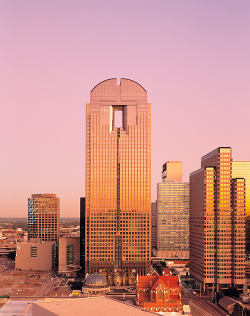by Ashley Katz — The Chase Tower Dallas, a 1.3 million+ square foot building in the heart of the Arts District in downtown Dallas, Texas, has been a fixture of the city’s skyline since its completion in 1987. Designed by world-renowned architect Richard Keating while at Skidmore, Owings & Merrill, the project stands 55 stories tall and is known to locals as “The Keyhole Building” for its seven story open-air feature near the building’s curved glass crown. Today, Chase Tower is not only renowned for its architectural beauty, but also for its sustainability, reborn as a green building and recognized as the first high rise in Dallas to achieve LEED Gold as an existing building.
Acquired by Houston-based Hines in 1997, the international real estate firm oversees management and leasing for the building, whose current tenants in Chase Tower Dallas include Deloitte LLP, Fulbright & Jaworski, JPMorgan Chase, and Locke Lord Bissell & Liddell LLP.
PROJECT DATA
| Project Start Date: | August 31, 2009 |
| Project End Date: | September 16, 2010 |
| Number of gross sq. ft. in building: | 1,296,407 |
| Number of rentable sq. ft. in building: | 1,243,667 |
| Primary owner: | Hines REIT |
| Level of certification rating: | LEED Gold |
Rating System:
LEED for Existing Buildings: Operations & Maintenance
Breakdown of LEED-EBOM score by category:
- Sustainable Sites: 5 (out of 12)
- Water Efficiency: 7 (out of 10)
- Energy & Atmosphere: 18 (out of 30)
- Materials & Resources: 6 (out of 14)
- Indoor Environment Quality:10 (out of 19)
- Innovation in Operations: 7 (out of 7)
- TOTAL: 53 (out of 92)
With over 200 projects representing more than 107 million square feet of LEED project space, Hines is regarded as one of the largest sustainable real estate organizations in the world. Offering the most efficient operations possible while maintaining a Class A building is a central goal of all Hines owned and managed buildings, and was no exception for Chase Tower. LEED certification was an important consideration for many of the project’s existing tenants and a key aspect of attracting prospective tenants.
“Pursuing a high level of LEED certification for Chase Tower was important to Hines,” said Daniel Tice, Engineering Manager, Hines. “Pursuing LEED Gold was an attainable challenge that wouldn’t compromise the quality of service provided to its tenants.”
Continued Tice, “As a long-time building owner, Hines fully understands the importance of operating equipment at maximum efficiency in order to achieve payback on capital expenditures through reduced operating costs.”
The project was completed in just one year with the help of Texas-based firms Kirksey Architecture and TMD Engineers.
With significant experience in sustainable design, construction and retrofitting, Hines was able to reduce or eliminate construction cost premiums for many of the green technologies it implemented. Careful planning and data gathering happened before the project even got off the ground.

Hines undertook numerous sustainability measures in order to achieve LEED Gold, including building commissioning, whole-building water metering, installing low-flow fixtures throughout, implementing a comprehensive recycling and green cleaning program, and rolling out the Hines’ GREEN OFFICE for Tenants program.
The project underwent building commissioning in order to provide further clarity into opportunities for improving building performance. Commissioning existing building systems helps reveal deficiencies and identify potential for increases in energy efficiency and decreases in operating costs. Through the investigation and analysis portion of the commissioning process, Hines implemented no-cost and low-cost operational improvements and minor repairs for major energy-using equipment. Following the initial commissioning, the project determined that it would implement an ongoing commissioning program to proactively address operating problems. The program includes elements of planning, system testing, performance verification, corrective action response, ongoing measurement and documentation.
In an effort to monitor ongoing water use, Hines installed water meters that measure the total potable water use for the entire building and associated grounds. The meter readings are continuously logged through manual recordings on a daily basis and help project operators understand consumption patterns and identify opportunities for additional water savings.
Additionally, the project team conducted an audit of the building’s consumable waste stream and used the results to identify opportunities for increased recycling and waste diversion. Property management identified a goal of diverting at least 75% of all construction waste.

Through its GREEN OFFICE for Tenants program, Hines is able to help tenants reduce environmental impacts in their spaces. The program encourages tenants to identify and implement no-cost and low-cost alternatives to operating in a standard indoor office environment. Scored on a scale of 100, offices are evaluated in seven categories: Energy Efficiency, People & Atmosphere; Travel & Commuting; Reduce, Reuse & Recycle; Cleaning; Remodeling & Construction; and LEED. When a specific strategy or improvement has been implemented, participating tenants earn “Leaf Credits.” If an office achieves 70 Leaf Credits, it’s then designated as a GREEN OFFICE.
Since the launch of the program in 2009, more than 700 tenants, such as Bank of America, Coca-Cola, Deloitte & Touche, GE Healthcare, JPMorgan Chase, KPMG, the San Diego Padres, Shell, Verizon and Wells Fargo—representing more than 36.3 million square feet—have achieved the designation.
Following its LEED certification, Chase Tower announced that by the end of 2010, they had reduced overall electricity consumption by almost 5%, reduced water consumption by 15%, and recycled 150 tons of paper. Over 70% of the tenants at Chase Tower have been recognized as a Hines “Green Office” based on their efforts. Moving forward, Chase Tower aims to continue finding efficiencies in the way the building operates and focusing on continuous improvement of the common areas of the building both inside and outside.